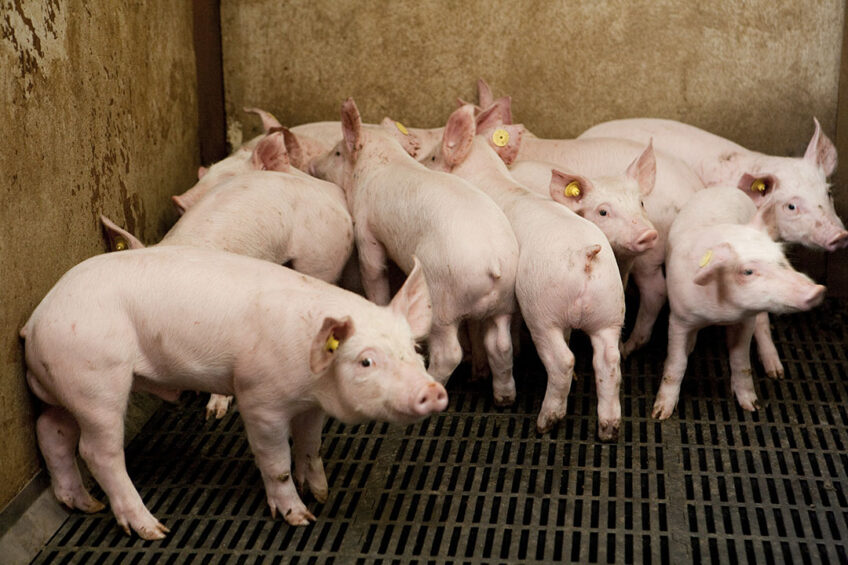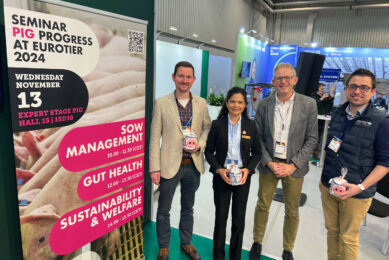Report + webinar: footprint of entire male pigs in Europe

There are various reasons to reconsider the application of piglet castration. Ethical or welfare reasons could be one, pragmatic reasons could be another, pig health or even feed efficiency. To all that, also an environmental reason has emerged.
The livestock sector has an important role in global greenhouse gas emissions. Mitigation strategies aimed at reducing the emission intensity of this sector are needed to limit the environmental burden from food production.
Greenhouse gas (GHG) emissions from pig houses are principally influenced by floor type, manure management and nutrition of the pigs. The main dietary strategy proposed for the abatement of pollutant gas emissions is the manipulation of the levels of crude protein and fibre content in the diet. An alternative option to reduce greenhouse emissions is improving the feed utilisation. Shifting from barrows to boars contributes to better feed utilisation.
Castration of male piglets
Castration of male piglets is regarded as an infringement of the wellbeing and integrity of the animal. Partly for that reason, the issue of the castration of male piglets has grown in importance in the last decade. The complexity of the subject represents a challenge for all those concerned. Not only does it involve many different parties across the pork supply chain, but the practical aspects are complex and multi-faceted.
It was estimated that by January 2018, large pork food supply chains in 8 major pork producing countries have established successful directions for solutions for ending surgical castration. However, in most of the other countries there is still no or little sense of urgency to achieve the ambition of ending castration, and each year 100 million pigs are castrated in the European Union.
European Farm to Fork strategy
The European Commission published its Farm to Fork strategy in May 2020. The strategy is at the heart of the European Green Deal aiming to make food systems fair, healthy and environmentally friendly. Taking into account that ending castration does not only improve animal welfare, but also results in improved feed efficiency and thus making the food system also more environmentally friendly it could be concluded that ending castration contributes to the goals of the farm to fork strategy in more than one way.
APS footprint method for pig production
The footprint of pig production can be calculated using the Animal Production System footprint tool, developed by Blonk Consultants in 2020. The APS footprint framework enables to conduct environmental footprint calculations based on background datasets, parameters defined by the user and modelling of emissions according to specified standards and guidelines. Pig systems may vary in design and environmental performance due to differences in herd composition, housing types, feeding regimes and management systems.
The pig APS module enables a user to model these different characteristics and investigate how they influence environmental impacts.
In the APS footprint module for pigs it is possible to change parameters and implement interventions on both the piglet breeding phase and on the pig fattening phase. Both have a relevant contribution to overall impacts (piglets on average 25% and fattening around 75% of environmental impact).
Feed is the main input of the pig APS. Feed production includes the cultivation and processing of crop and minerals and additives production. Cultivation datasets in agri-footprint include e.g. land occupation, water inputs, fuel production, fertiliser use, emission of transport, etc.
Input data for the footprint calculations
Generic input data for calculating the footprint of pig production are the footprint of feed for fattening pigs (1.0 kg feed for growing pigs = 1.0 kg CO2 eq.) and the footprint of piglet production (1 piglet = 123 kg CO2 eq. per piglet). A mortality of 2.5% is assumed.
Country-specific data were collected for Belgium, Denmark, France, Germany and the Netherlands, all major pig producing countries. The UK, Spain and Portugal are not included as pig production in these countries already for decades is mainly based on entire male pigs.
Collected observational data are based on 2,700 French farms over the year 2020 and 420 Dutch farms over the average of the years 2016-2020. Experimental data for Belgium, Denmark and Germany (two studies) are included in Table 1.
On French farms the feed intake between boars and barrows is almost equal, because in France restricted feeding is applied. Therefore the difference in feed conversion rate is less pronounced.
Results of boar footprint
The calculated results of the footprint of boars and barrows are presented in Tables 2 and 3. The footprint of barrows expressed in kg CO2 eq. per kg live weight at slaughter ranges from 3.92 to 4.45. Higher footprints mostly go along with higher feed conversion rates. The footprint of boars is lower compared to the footprint of barrows, the reduction in footprint ranging from 6% to 14%. However, for the countries where observational data from commercial farms are available, the reduction ranges from 6% to 9%.
Taking into account the results described in the literature regarding CO2-, CH4- and N2O-production from animals and manure in pig houses, our estimates are in line. In 2015, researchers François Xavier Philippe and Baudouin Nicks, from the University of Liège in Belgium, estimated GHG emissions equal to 4.87 kg CO2 eq. per kg carcass weight. The calculated change in land use as a result from shifting to boars, is quite similar to the calculated changes in kg CO2 eq., ranging from 7% to 14%.
Concluding remarks
This study shows that producing boars instead of barrows results in a significantly better feed utilisation and thus a lower footprint. Many farms may expect a reduction in feed usage of 7% to 9% when shifting from barrows to boars, resulting in 3.5% to 4.5% lower feed costs (when also gilts are taken into account).
Assuming the approximately 100 million barrows annually slaughtered in the EU need 24 kg more feed compared to boars, and also assuming that the feed ingredients for growing pigs are harvested at 8 tonnes per ha, this equals to 300,000 ha land use saved.
Assuming a reduction of 0.35 kg CO2 eq. per kg live weight and a live slaughter weight of 125 kg per pig, this results for the 100 million barrows in the EU annually slaughtered in a lower footprint of in total 4.4 million tonnes CO2 eq. per year.
For food companies, the estimated substantial favourable impact of producing entire male pigs on the carbon footprint may be an incentive to consider it an option to shift towards marketing meat from entire male pigs. All the more because as of January 2023 the Corporate Sustainability Reporting Directive (CSRD) entered into force. This new directive modernises and strengthens the rules about the social and environmental information that companies have to report.
This article is a summary of the report “Footprint of entire male pigs in Europe,” which was commissioned by the Boars on the Way initiative in cooperation with the Netherlands Feed Industry Association (Nevedi). It was published in February 2023.











